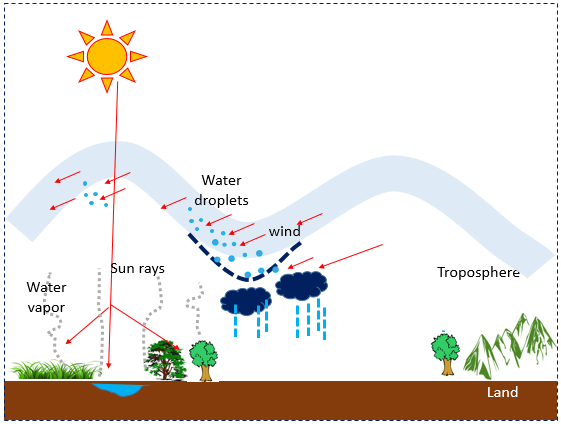The followers of Sri Ramalingam alias Vallalar might be aware of Vallalar’s statement “One day, Vadalur will become Cuddalore”. I have been thinking for long time, what it means?
The towns Vadalur and Cuddalore belong to South Arcot district (figure-1) until early 1990s, in Tamil Nadu province, India. Since the South Arcot district is very large in size, it was divided into two districts during 1991-1995. Then, Vadalur and Cuddalore became part of Vallalar Ramalinga Adigal district. The devotees of Vallalar were happy and they claimed that the Vallar’s statement came true, as the district was named in the name of Vallalar. The district name has been changed in few years’ time to Cuddalore district. For sure, Saint Vallalar did not mean this, because saints do not care about fame and name.
The saints in the past did not leave the messages clearly to the people, which raises lot of confusion among the readers in understanding their language. It is true that they say for some reason, which may take years for people to understand. With this background, I have tried to construct a hypothetical/imaginary scenario for Vallalar’s historical statement by analyzing geography and history of the region, which may not be necessarily true.
In Tamil language, “Cuddalore means the place near the sea or coast land (kadal:Sea +Voor:Place) ”. Vallalar’s statement “Vadalur will become Cuddalore” may be a hint that sea water intrusion may bring a shore line closer to Vadalur. It may be a long term lanscape change prediction. Is this possible scientifically? I am not sure. Also I wonder, it may not happen in the near future, but may be possible after several hundred years or so. Nature is so complicated to understand or predict.
Natural hazards are powerful enough to destroy a place without any trace of people lived there, for example, a cyclone in 1964 washed a place called Danushkodi (figure-1) near Rameshwaram, thousands of people were killed, and a train was washed away with hundreds of passengers. Now there are no trace of humans lived in the place, it is like a ghost town with damaged buildings, and no one lives there at present. The Tsunami 2004 washed few villages in Tamil Nadu completely without any trace. In the history, we have studied that the old Poombukar city was submerged in the Sea. All these past experiences raises a doubt that anything can happen.
 Figure-1 shows the locations of three major towns Vadalur, Cuddalore, and Chidambaram. The elevation and bathymetry of the region is also plotted. Vadalur is approximately 20 kilometers from the existing shoreline. Is it possible to have sea water intrusion for 20kms? Our human mind from the past experience will say definitely NO, as we have not seen such disastrous sea level rise or intrusion in the past 100 years. Definitely, we are not the creators of the universe, so we may not know the nature’s behavior in the future. But, the relatively lower elevation regions (highlighted in red and orange color – 2 to 5m from mean sea level) along the coast line are vulnerable for sea water intrusion and shore line changes.
Figure-1 shows the locations of three major towns Vadalur, Cuddalore, and Chidambaram. The elevation and bathymetry of the region is also plotted. Vadalur is approximately 20 kilometers from the existing shoreline. Is it possible to have sea water intrusion for 20kms? Our human mind from the past experience will say definitely NO, as we have not seen such disastrous sea level rise or intrusion in the past 100 years. Definitely, we are not the creators of the universe, so we may not know the nature’s behavior in the future. But, the relatively lower elevation regions (highlighted in red and orange color – 2 to 5m from mean sea level) along the coast line are vulnerable for sea water intrusion and shore line changes.
 You may notice a “C” type coast line seen from Cuddalore (north) to Cuddalore (south) in figure 2, the converging zone is positioned straight (same longitude) to Vadalur. There are large water bodies, canals existing in the region, closer to Vadalur from the coast. Also, the lower elevation regions <5m from MSL might be a threat. All these geographical features may pave a way for coastal water to penetrate easily into inland in the next century or several century later. Such havocs situation may convert the Vadalur, an inland town to a coastal town.
You may notice a “C” type coast line seen from Cuddalore (north) to Cuddalore (south) in figure 2, the converging zone is positioned straight (same longitude) to Vadalur. There are large water bodies, canals existing in the region, closer to Vadalur from the coast. Also, the lower elevation regions <5m from MSL might be a threat. All these geographical features may pave a way for coastal water to penetrate easily into inland in the next century or several century later. Such havocs situation may convert the Vadalur, an inland town to a coastal town.
At the same time, Chidambaram is located closer to the coast than Vadalur. So, the threat is same for Chidambaram too? NO, from my opinion. Chola Kings are amazing visionaries in locating and constructing temples at a right place for having long standing temples, more than thousand years. Lord Nararaja temple in Chidambaram is one of the important architecture work by early Cholas and later many have contributed to this temple including pallavas, cheras, later cholas etc.,. Even, Vallalar was so much attached to this temple. This raises a question to me, how protective the Chidambaram temple is from coastal hazards? Look at the figure-2, there are mangroves located straight to the temple along the shore line. The mangroves which we see is the current extent, which may be more in the past. Mangroves are protective enough for this temple and people in the region. These mangroves protected few villages from tsunami 2004. Now many countries are planting and preserving mangrove forest to protect from the coastal hazards. Hence this may be a reason, why Vallalar did not mention about Chidambaram in his statement. Our ancestors were very much aware of geography for establishing new settlement places, agriculture activities, water management structures and other activities.

